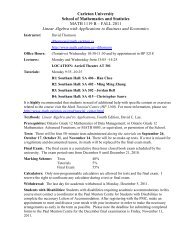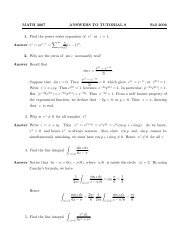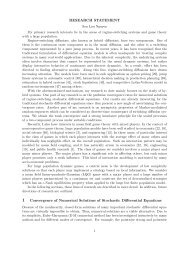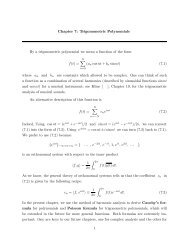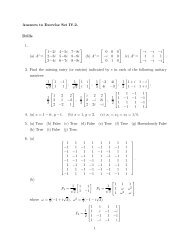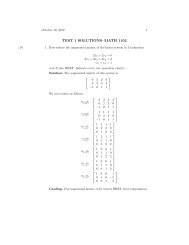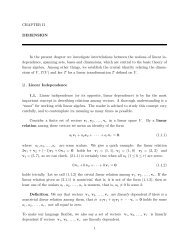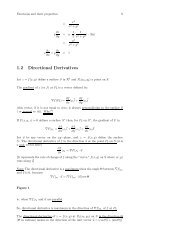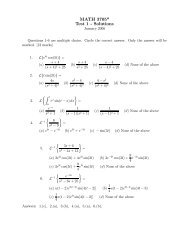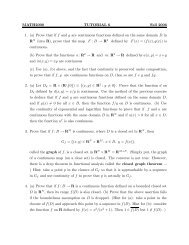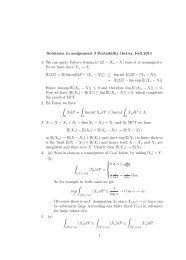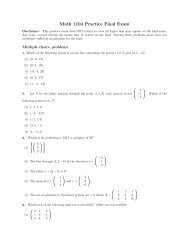CHAPTER 5. VECTORS IN DIMENSION THREE OR HIGHER Part 1 ...
CHAPTER 5. VECTORS IN DIMENSION THREE OR HIGHER Part 1 ...
CHAPTER 5. VECTORS IN DIMENSION THREE OR HIGHER Part 1 ...
Create successful ePaper yourself
Turn your PDF publications into a flip-book with our unique Google optimized e-Paper software.
<strong>CHAPTER</strong> <strong>5.</strong> <strong>VECT<strong>OR</strong>S</strong> <strong>IN</strong> <strong>DIMENSION</strong> <strong>THREE</strong> <strong>OR</strong> <strong>HIGHER</strong><br />
<strong>Part</strong> 1. Vectors in 3D and the Cross Product<br />
Recall that the dot product (or inner product) u • v of two planar vectors<br />
u = (u1, u2) and v = (v1, v2) is given by<br />
u • v = u1v1 + u2v2.<br />
For vectors u = (u1, u2, u3) and v = (v1, v2, v3) in the Euclidean 3-dimensional space<br />
R 3 , the dot product (or inner product) u • v is defined by putting<br />
and the magnitude of v is given by<br />
u • v = u1v1 + u2v2 + u3v3.<br />
|v| =<br />
<br />
v 2 1 + v 2 2 + v 2 3.<br />
The identities u • v = |u||v| cos θ and |u| 2 = u • u still hold. Also, two vectors u and<br />
v are perpendicular, or u ⊥ v, if and only if u • v = 0. Let us also recall that the area<br />
of the parallelogram spanned by vectors u = (a,b) and v = (c,d) is equal to the absolute<br />
value of the determinant <br />
a b <br />
<br />
c d<br />
≡ ad − bc.<br />
A 3 × 3 determinant is defined via the following recipe:<br />
<br />
w1 <br />
<br />
u1<br />
<br />
<br />
w2<br />
u2<br />
<br />
w3 <br />
<br />
<br />
u3 = w1u2v3 + w2u3v1 + w3u1v2 − w3u2v1 − w2u1v3 − w1u3v2.<br />
<br />
<br />
(<strong>5.</strong>1)<br />
v1 v2 v3<br />
This recipe is not readable. One must recognize a pattern of the right hand side in order<br />
to use it efficiently. Notice that the right hand side can be written as<br />
w1u2v3 + w2u3v1 + w3u1v2 − w3u2v1 − w2u1v3 − w1u3v2<br />
= w1(u2v3 − u3v2) + w2(u3v1 − u1v3) + w3(u1v2 − u2v1)<br />
= w1(u2v3 − u3v2) − w2(u1v3 − u3v1) + w3(u1v2 − u2v1)<br />
<br />
u2 u3 u1 u3 u1 u2 <br />
= w1 <br />
− w2 <br />
+ w3 <br />
. (<strong>5.</strong>2)<br />
v2 v3<br />
v1 v3<br />
1<br />
v1 v2
The absolute value of the 3 × 3 determinant in (<strong>5.</strong>1) gives us the volume of the paral-<br />
lelepiped spanned by vectors w = (w1, w2, w3), u = (u1, u2, u3) and v = (v1, v2, v3).<br />
Identity (<strong>5.</strong>2) suggests the following definition of the cross product u × v of vectors<br />
u = (u1, u2, u3) and v = (v1, v2, v3):<br />
<br />
u2 u3 <br />
u × v = <br />
, −<br />
<br />
v2 v3<br />
u1 u3<br />
v1 v3<br />
<br />
<br />
<br />
,<br />
<br />
<br />
<br />
<br />
u1 u2<br />
v1 v2<br />
To give a quick example, let u = (1, 1, 2) and v = (2, −1, 3). Then<br />
<br />
1<br />
u × v =<br />
−1<br />
<br />
2<br />
1<br />
<br />
3<br />
, −<br />
<br />
2<br />
<br />
2<br />
<br />
3<br />
,<br />
<br />
1<br />
<br />
<br />
2<br />
<br />
1 <br />
<br />
−1<br />
= (5, 1, −3).<br />
Notice that<br />
u•(u×v) = (1, 1, 2)•(5, 1, −3) = 5+1−6 = 0, v•(u×v) = (2, −1, 3)•(5, 1, −3) = 10−1−9 = 0.<br />
In other words, u, v ⊥ u × v. In the future, we shall see that this is not accidental.<br />
The right hand side of (<strong>5.</strong>2) is just w • (u × v). So we can rewrite (<strong>5.</strong>2) as<br />
<br />
w1 <br />
<br />
w • (u × v) = u1<br />
<br />
<br />
w2<br />
u2<br />
<br />
w3 <br />
<br />
<br />
u3 <br />
<br />
<br />
v1 v2 v3<br />
We give a quick example:<br />
<br />
<br />
<br />
1<br />
<br />
(1, 3, 2) • { (1, 1, 2) × (2, −1, 3) } = 1<br />
<br />
2<br />
3<br />
1<br />
−1<br />
<br />
2<br />
<br />
<br />
2<br />
= 3 + 12 − 2 − 4 − 9 + 2 = 2<br />
<br />
3<br />
<br />
<br />
<br />
<br />
<br />
.<br />
(<strong>5.</strong>3)<br />
which is the volume of the parallelepiped spanned by vectors (1, 3, 2), (1, 1, 2), (2, −1, 3).<br />
Here are the basic properties about cross products:<br />
(C1) u × v = −v × u, and v × v = 0.<br />
(C2) (au + bv) × w = a u × w + b v × w<br />
(C3) u × v is perpendicular to both u and v.<br />
(C4) The triple u, v, u × v obeys the right hand rule.<br />
(C5) |u × v| is the area of the parallelogram spanned by u, v, that is, |u||v| sin θ,<br />
where θ is the angle between u and v.<br />
2
(C6) |w • (u ×v)| is equal to the volume of the parallelepiped spanned by w, u, v.<br />
Properties (C1) and (C2) are more or less easy to check. I leave their checking to you as<br />
an exercise. Now we check (C3). In order to show that u × v is perpendicular to u, it<br />
is enough to check that their dot product is zero. Indeed, by (<strong>5.</strong>3), we have<br />
<br />
u1 <br />
<br />
u • (u × v) = u1<br />
<br />
<br />
u2<br />
u2<br />
<br />
u3 <br />
<br />
<br />
u3 = 0<br />
<br />
<br />
v1 v2 v3<br />
because the first two rows of the determinant are identical. Hence u ⊥ (u × v). In the<br />
same way, we can show that v ⊥ (u × v). To see (C5), let φ be the angle between w<br />
and u × v. Then w • (u × v) = |w| |u × v| cos φ ≡ (|w| cos φ) |u × v|. Now, think of<br />
u and v as vectors in horizontal directions. Then, by (C3), we see that u × v is in the<br />
vertical direction. So |w| | cos φ| is equal to the height h of the parallelepiped spanned<br />
by u, v, w; see the following figure of a “side view” of this parallelepiped.<br />
Figure 1.<br />
As we know, |w • (u × v)| is the volume V of the parallelepiped. On the other hand, the<br />
volume V is just bh, where h, as before, is the height the parallelepiped and b is the area<br />
of its base, which is the (spatial) parallelogram spanned by u and v. Thus we have<br />
bh = V = |w • (u × v)| = |w||u × v| | cos φ| = (|w|| cos φ|) |u × v| = h|u × v|.<br />
Cancelling h, we obtain b = |u×v|. The last identity tells us the validity of property (C5).<br />
Finally, (C6) follows from (<strong>5.</strong>3) and the geometric interpretation of a 3 × 3 determinant:<br />
its absolute value is the volume of the parallelepiped spanned by its row vectors.<br />
3
The cross product, especially its Properties (C3) and (C5), is very useful in spatial<br />
geometry, as well as in physics (such as torque, Lorentz force, etc).<br />
Property (C3) tells us |u × v| = |u||v| sin θ, which gives |u × v| 2 = |u| 2 |v| 2 sin 2 θ.<br />
On the other hand, u • v = |u||v| cos θ gives (u • v) 2 = |u| 2 |v| 2 cos 2 θ. Thus<br />
(u • v) 2 + |u × v| 2 = |u| 2 |v| 2 (cos 2 θ + sin 2 θ) = |u| 2 |v| 2 .<br />
We have arrived at a rather amazing and beautiful identity:<br />
Writing down in its full glory, we have<br />
(u1v1+u2v2+u3v3) 2 <br />
<br />
+ <br />
<br />
u2 u3<br />
v2 v3<br />
(u • v) 2 + |u × v| 2 = |u| 2 |v| 2 .<br />
2<br />
<br />
<br />
<br />
+ <br />
<br />
u1 u3<br />
v1 v3<br />
2<br />
<br />
<br />
<br />
+ <br />
<br />
u1 u2<br />
v1 v2<br />
2<br />
<br />
<br />
= (u 2 1+u 2 2+u 2 3)(v 2 1+v 2 2+v 2 3). (<strong>5.</strong>4)<br />
Certainly you can verify this identity by using brute force of algebraic manipulation.<br />
Exercise <strong>5.</strong>1. Expand both sides of (<strong>5.</strong>4) and then check that they are identical.<br />
Notice the resemblance of (<strong>5.</strong>4) to (4.19):<br />
(a 2 + b 2 )(c 2 + d 2 ) = (ac + bd) 2 + (ad − bc) 2<br />
Indeed, (<strong>5.</strong>4) is the “3–dimensional version” of (4.19).<br />
Exercise <strong>5.</strong>2. Use the vectors u = (2, 5, 3) and v = (7, −1, −3) to fabricate<br />
(2 2 + 5 2 + 3 2 )(7 2 + 1 2 + 3 2 ) = 12 2 + 27 2 + 37 2 .<br />
Now you can challenge your friend (who is not taking MATH0107) or your parents to find<br />
three positive integers x, y, z so that (2 2 +5 2 +3 2 )(7 2 +1 2 +3 2 ) = x 2 +y 2 +z 2 . You can<br />
use more complicated numbers to fabricate other “amazing identities” to surprise them.<br />
Note: the cross product u × v is defined only for vectors in the three dimensional<br />
space, while the dot product u•v can be defined for vectors in a space of any dimension.<br />
<strong>Part</strong> 2. Vectors in Higher Dimensional Spaces<br />
4
In our previous sections we have seen that, by introducing the Cartesian coordinate<br />
system, a vector u in a 2 dimensional space can be identified with an ordered pair (u1, u2)<br />
of numbers and a vector v in a 3 dimensional space can be identified with an ordered triple<br />
(v1, v2, v3). Naturally we can regard a vector in an n–dimensional space as an ordered<br />
n-tuple: v = (v1, v2, ..., vn). Here, n is any positive number.<br />
Let u = (u1, u2, ..., un) and v = (v1, v2, ..., vn) be two vectors in the n-<br />
dimensional space. According to the usual convention, we require<br />
1. u = v if and only if u1 = v1, u2 = v2, ..., un = vn; that is, two vectors are the<br />
same if and only if their corresponding components are equal;<br />
2. (addition) u + v = (u1 + v1, u2 + v2, ..., un + vn); that is, adding two vectors is<br />
carried out by adding their corresponding components;<br />
3. (scalar multiplication) au = (au1, au2, ..., aun); that is, multiplying a vector by a<br />
scalar is carried out by multiplying each component by the same scalar;<br />
4. (negation) −u = (−u1, −u2, ..., −un).<br />
<strong>5.</strong> (magnitude, or norm, or length) |u| = u 2 1 + u 2 2 + · · · + u 2 n.<br />
6. (inner product, or dot product) u • v = u1v1 + u2v2 + · · · + unvn.<br />
To give a quick example, suppose that u = (1, 3, −3, −1, −4) and v = (−5, 2, 1, 5, −3)<br />
are given vectors in the 5–dimensional space. Then we have<br />
u + v = (−4, 5, −2, 4, −7)<br />
−3u = (−3, −9, 9, 3, 12)<br />
|u| = 1 2 + 3 2 + (−3) 2 + (−1) 2 + (−4) 2 = 6<br />
|v| = (−5) 2 + 2 2 + 1 2 + 5 2 + (−3) 2 = 8<br />
u • v = 1 × (−5) + 3 × 2 + (−3) × 1 + (−1) × 5 + (−4) × (−3) = <strong>5.</strong><br />
The usual identities such as u •v = v •u, u •(av+bw) = a u •v+b u •w, |u| 2 = u •u,<br />
etc. still hold.<br />
The n-dimensional space, consisting of all n–tuples of the form u = (u1, u2, ..., un)<br />
regarded as vectors, is called the n–dimensional (real) Euclidean space and is denoted by<br />
R n . Why are we interested in vectors from higher dimensions? A blunt answer is: in<br />
applying vector algebra to natural or social sciences, we must allow such vectors.<br />
5
Example (a fairy tale). In this example we consider 5 characters in a fairy tale:<br />
Princess Barbe, Prince Ken, the evil Prime Minister Mandragora, the witch Fata Morgana,<br />
and some girl called Ligneous. Each character is endowed with a vector consisting of 4<br />
components, representing look, personality, social status and color of dressing, with 10<br />
marks as maximum and −10 as minimum. For example, in the “look department” both<br />
Barbe and Ken earn a perfect 10. Mandragora is also good looking (after all, he believes<br />
his look could win the princess’ heart), but not as good looking as the prince: so he gets<br />
a mark of 9. Fata Morgana is the ugliest person: so she receives a −10. Ligneous has a<br />
“buttered face”: she gets 0. The Princess also earns a perfect 10 in personality. But her<br />
social status is only a 6 even though she is a princess, because she lived in an era 400<br />
years before the word “feminists” was invented. For color of dressing, 10 is for white and<br />
−10 is for dark. Here is a summary of characters and their respective vectors of their<br />
attributes.<br />
Princess Barbe: b = (10, 10, 6, 10)<br />
Prince Ken: k = (10, 6, 10, 10)<br />
Mandragora: m = (9, −10, 9, −10)<br />
Fata Morgana: f = (−10, −10, −10, −10)<br />
Ligneous: L = (0, 0, 0, 0)<br />
Now we consider the dot products of various pairs of vectors to see if two persons are<br />
compatible. For Ken and Barbe, the high score b • k = 340 tells us that they will get<br />
married at the end of the story. For Mandragora and Barbe, m • b = −56, showing<br />
that they are not compatible. For Mandragora and Fata Morgana, m • f = 20, which is<br />
small but still positive. This shows that Mandragora and Fata Morgana can get along<br />
with each other and work together, but they would not get married. Mandragora should<br />
be advised to change his dress from black to white, because this will greatly improve his<br />
chance of getting close to the princess. Indeed, after changing the last component −10 in<br />
m to 10, we get m • b = 144, a substantial improvement. As for Ligneous, L • v = 0 for<br />
any vector v: she is indifferent to any one. For all except Ligneous, the corresponding<br />
vectors have large magnitude, indicating that they have strong characters. For Ligneous,<br />
|L| = 0, showing that she has no character and should not even be in the story.<br />
Example (another fairy tale). For Cinderella, C = (10, 10, −10, −10), her two<br />
sisters, s = (−1, 0, 10, 10), t = (1, −1, 10, 10), and the prince, P = (10, 8, 10, 10), we<br />
6
have C • P = −20, s • P = 190 and t • P = 202. It seems that Cinderella cannot<br />
compete with her sisters. However, the Fairy Mother came and transformed C into<br />
T(C) = (10, 10, 10, 10) so that when she met the prince, P • T(C) = 380. She won the<br />
heart of the prince by the help of the Fairy Mother who temporally changed her vector<br />
of attributes.<br />
Example. Consider n social, economical or political issues. For each issue a score of<br />
10 stands for “strongly support” and −10 for “strongly oppose”, while 0 for “no opinion”.<br />
The scores of a person’s opinions form a vector with n components. If two persons have<br />
“opinion vectors” u and v respectively, then the dot product u • v measures the degree<br />
of their congruity. A person with the zero opinion vector may be regarded as apathetic.<br />
This person never agrees nor disagrees with any one, because he simply does not care.<br />
As usual, we say that two vectors u and v in R n are perpendicular and we write<br />
u ⊥ v if u • v = 0. We can generalize the Pythagoras theorem in n–dimension:<br />
Pythagoras Theorem. If u ⊥ v, then |u + v| 2 = |u| 2 + |v| 2 .<br />
The proof of this theorem (in this setting) is one line long:<br />
|u + v| 2 = (u + v) • (u + v) = u • u + 2u • v + v • v = u • u + v • v = |u| 2 + |v| 2 .<br />
Notice that u • v = 0 follows form the assumption u ⊥ v.<br />
Exercise <strong>5.</strong>3. Prove that if v ⊥ v, then v = 0.<br />
Problem <strong>5.</strong>4. The unit sphere in R n , denoted by S n−1 , is the set of all points P in<br />
R n so that |OP | = 1; in other words, the distance between P and the origin O is 1.<br />
When n = 2 (in the case of Euclidean plane), S n−1 becomes S 1 and we call it the unit<br />
circle. Using the set theoretical notation, we can write<br />
S 1 = {(x,y) ∈ R 2 |x 2 + y 2 = 1}.<br />
Fix a point A inside the unit sphere distinct from the origin: thus 0 < | −→<br />
OA| < 1. The<br />
so called polar of A, denoted by A ∗ , is the point outside of the unit sphere determined<br />
by the relation<br />
−−→<br />
OA ∗ = 1<br />
|OA| 2<br />
−→<br />
OA<br />
7
You should notice that −−→<br />
OA ∗ is a multiple of −→<br />
OA by a positive scalar and |OA| |OA ∗ | = 1.<br />
Now you are asked to verify the following highly nontrivial fact: For any point P on the<br />
unit sphere S n−1 , the ratio<br />
|A ∗ P |<br />
|AP |<br />
is independent of the choice of P. In other words, if both P and Q are on S n−1 , then<br />
|A ∗ P |/|AP | = |A ∗ Q|/|AQ|.<br />
Figure 2.<br />
Let us consider the following important problem: given two vectors w and v in the<br />
space R n with w = 0, find the so-called orthogonal decomposition of v:<br />
v = aw + h, (<strong>5.</strong>5)<br />
where a is a scalar and h is perpendicular to w: h ⊥ w. In other words, we need to find<br />
an explicit recipe to write v as the sum of two vectors, one is parallel to w and the other<br />
is perpendicular to w. The vector aw here will be called the (orthogonal) projection<br />
of v onto w. A visual aid of this problem is given as follows:<br />
8
Take the dot product of both sides with vector w:<br />
v • w = a w • w + h • w = a w • w.<br />
Figure 3.<br />
Notice that h • w = 0, because h ⊥ w by assumption. Also, we may rewrite w • w as<br />
|w| 2 ; but here we prefer not to do so. Thus we arrive at a = v •w/w •w. In conclusion,<br />
the answer to our important question is given as follows:<br />
v = p + h where p =<br />
v • w<br />
w, the projection of v onto w. (<strong>5.</strong>6)<br />
w • w<br />
Note that, once we obtain the projection p, we get h for free: h = v − w. As a quick<br />
example, take vectors v = (3, 5, 2) and w = (2, 1, −1) in R 3 . Then the projection of<br />
v onto w is given by<br />
p =<br />
<br />
v • w 6 + 5 − 2 3<br />
w = w = w = 3,<br />
w • w 4 + 1 + 1 2 3<br />
<br />
−3<br />
,<br />
2 2<br />
and hence h = v − p = (0, 7/2, 7/2). Thus we have the following orthogonal decomposi-<br />
tion for v: (3, 5, 2) = (3, 3/2, −3/2) + (0, 7/2, 7/2).<br />
Applying the Pythagoras theorem to the orthogonal decomposition v = p + h, we<br />
get |v| 2 = |p| 2 + |h| 2 . Since |h| 2 ≥ 0, we have |v| 2 ≥ |p| 2 . Upon taking square roots<br />
on both sides, we have |v| ≥ |p|. Now<br />
<br />
v • w<br />
|v| ≥ |p| = <br />
w • w w<br />
<br />
<br />
=<br />
9<br />
|v • w|<br />
|w| 2 |w| =<br />
|v • w|<br />
|w|
So we have |v •w| ≤ |v||w|, which is the the celebrated Cauchy-Schwarz inequality.<br />
The argument here gives a proof of the Cauchy-Schwarz inequality.<br />
Exercise <strong>5.</strong><strong>5.</strong> In each of the following cases, find the dot product u • v and<br />
the cross product u × v of the given vectors u and v in R 3 , and check that u × v is<br />
perpendicular to both u and v: (a) u = (1, 1, 2), v = (2, 3, 1) (b) u = (−1, 1, 4), v =<br />
(3, −2, 2) (c) u = (1,a,a 2 ), v = (1, 1, 1). (d) u = (cosαsin β, cosαcosβ, − sin α),<br />
v = (sinαcos β, − sin α sin β, 0).<br />
Exercise <strong>5.</strong>6. In each of the following cases, find the area of the triangle ∆ABC with<br />
the given points A, B, C in R 3 . (a) A = (1, 1, 1), B = (1, 2, 3), C = (3, 3, 1) (b)<br />
A = (0, 0, 0), B = (cosαsin β, cos α cos β, − sin α), C = (sinαcos β, − sin α sin β, 0).<br />
Exercise <strong>5.</strong>7. In each of the following cases, find the magnitudes |u|, v| and the dot<br />
product u • v of the given vectors: (a) u = (1, −1, 1, −1), v = (1, 1, −1, −1) (b)<br />
u = (cosα + cos β, sin α + sinβ, cos α − cos β, sin α − sin β),<br />
v = (− cos α − cos β, − sin α + sinβ, − cos α + cos β, sin α + sin β)<br />
Exercise <strong>5.</strong>8. Let S = (s1, s2, ..., s1500) be vector showing the results of investi-<br />
gating 1500 people for smoking. The k component sk is assigned a value of −1, 0 or<br />
+1 according to the following results of investigating the kth respondent: heavy smoker,<br />
occasion smoker, or non–smoker. Let C = (c1, c2, ..., c1500) be a vector obtained based<br />
on the health information of these 1500 respondents: ck is −1, 0 or +1 according to the<br />
following conditions of the kth person: having cancer, not known, no cancer. What is<br />
your interpretation of each of the following possible outcomes? (a) S • C = 1200, (b)<br />
S • C = 0 (c) S • C = −1200.<br />
Exercise <strong>5.</strong>9. In each of the following cases, find the projection of vector v onto vector<br />
w: (a) v = (1, 9, 7), w = (1, 1, 2) (b) v = (a + 3b, 3a + b,a + 2b), w = (b,a + b,a + b).<br />
Answers to Exercises and Problems<br />
<strong>5.</strong>1. We have<br />
(u1v1 + u2v2 + u3v3) 2 = u 2 1v 2 1 + u 2 2v 2 2 + u 2 3v 2 3 + 2u1v1u2v2 + 2u1v1u3v3 + 2u2v2u3v3<br />
10
u2 u3<br />
v2 v3<br />
u1 u3<br />
v1 v3<br />
u1 u2<br />
v1 v2<br />
<br />
<br />
<br />
<br />
<br />
<br />
<br />
<br />
<br />
<br />
<br />
<br />
2<br />
2<br />
2<br />
= (u2v3 − u3v2) 2 = u 2 2v 2 3 + u 2 3v 2 2 − 2u2v3u3v2<br />
= (u1v3 − u3v1) 2 = u 2 1v 2 3 + u 2 3v 2 1 − 2u1v3u3v1<br />
= (u1v2 − u2v1) 2 = u 2 1v 2 2 + u 2 2v 2 1 − 2u1v2u2v1<br />
Adding all four identities and cancelling all “cross terms”, we see that the left hand side<br />
of (4.4) is equal to<br />
u 2 1v 2 1 + u 2 2v 2 2 + u 2 3v 2 3 + u 2 2v 2 3 + u 2 3v 2 2 + u 2 1v 2 3 + u 2 3v 2 1 + u 2 1v 2 2 + u 2 2v 2 1<br />
This sum of nine terms is exactly the result of expanding the right hand side of (4.4).<br />
Now<br />
<strong>5.</strong>2. Notice that u•v = 2×7+5×(−1)+3×(−3) = 0. So we have |u×v| 2 = |u| 2 |v| 2 .<br />
<br />
5 3 2 3 <br />
u × v = <br />
−1 −3<br />
, −<br />
<br />
<br />
7 −3<br />
,<br />
<br />
2 5 <br />
<br />
<br />
7 −1<br />
= (−12, 27, −37).<br />
So |u × v| 2 = 12 2 + 27 2 + 37 2 . Also,<br />
|u| 2 = |(2, 5, 3)| 2 = 2 2 + 5 2 + 3 2<br />
and |v| 2 = |(7, −1, −3)| 2 = 7 2 + 1 2 + 3 2 .<br />
Hence |u| 2 |v| 2 = |u × v| 2 gives (2 2 + 5 2 + 3 2 )(7 2 + 1 2 + 3 2 ) = 12 2 + 27 2 + 37 2 .<br />
<strong>5.</strong>3. v ⊥ v means v •v = 0. So |v| 2 = v •v = 0. Thus the magnitude |v| of v is zero,<br />
which implies v = 0.)<br />
<strong>5.</strong>4. For convenience, let us write a = −→<br />
OA, a ∗ = −−→<br />
OA ∗ and p = −→<br />
OP. Then we have<br />
a ∗ = |a| −2 a, or |a| 2 a ∗ = a. In particular |a| 2 |a ∗ | = |a|, or |a||a ∗ | = 1. Also, since P is a<br />
point on the unit sphere, we have p • p = |p| 2 = 1. Now<br />
On the other hand,<br />
| −−→<br />
PA ∗ | 2 = | −−→<br />
OA ∗ − −→<br />
OP | 2 = |a ∗ − p| 2 = (a ∗ − p) • (a ∗ − p)<br />
= a ∗ • a ∗ − 2a ∗ • p + p • p<br />
= |a ∗ | 2 − 2a ∗ • p + 1 1 a 1<br />
− • p − 1 =<br />
|a| 2 |a| 2<br />
|a| 2 (1 − 2a • p + |a|2 )<br />
| −→<br />
PA| 2 = | −→<br />
OA− −→<br />
OP | 2 = |a−p| 2 = (a−p)•(a−p) = a•a−2a•p+p•p = |a| 2 −2a•p+1<br />
11
and hence | −−→<br />
PA ∗ | 2 /| −→<br />
PA| 2 = 1/|a| 2 , or | −−→<br />
PA ∗ |/| −→<br />
PA| = 1/|a|, which is clearly independent<br />
of P.<br />
<strong>5.</strong><strong>5.</strong> (a) u • v = 7, u × v = (−5, 3, 1) (b) u • v = 2, u × v = (14, 14, 0)<br />
(c) u • v = 1 + a + a 2 , u × v = (1 − a)(a, −a − 1, 1) (d) u • v = 0, u × v =<br />
sin α(sin α sin β, sin α cos β, − cos α)<br />
<strong>5.</strong>6. (a) 6 (b) | sin α|<br />
<strong>5.</strong>7. (a) 0 (b) −2<br />
<strong>5.</strong>8. (a) Smoking is a cause of cancer (b) Smoking does not cause cancer (c)<br />
Smoking can prevent cancer.<br />
<strong>5.</strong>9. (a) 4w = (4, 4, 8) (b) 2w = 2(b,a + b,a + b)<br />
12



